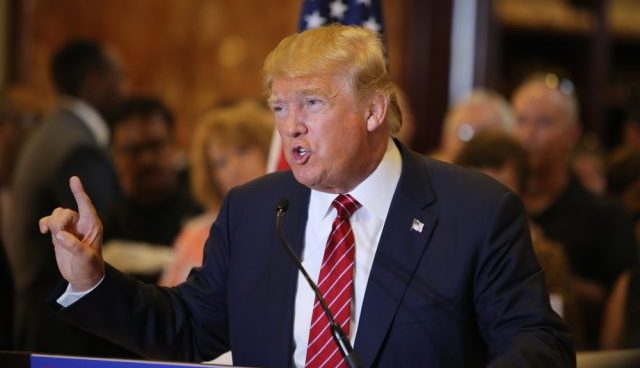
A federal judge in Kentucky has reconsidered his decision to allow a lawsuit against President Donald Trump to move forward on extremely specious reasoning. In response to pressure from the president and his attorneys, U.S. District Court Judge David J. Hale has paused the suit accusing Trump and others of incitement to riot in order to sort out a free speech issue.
There’s just one problem: none of the essential facts of the case have changed. What has changed since Hale originally allowed the case to go forward does not augur well for the president. One of his named co-defendants in the lawsuit, white nationalist Matthew Heimbach, took a plea deal on criminal charges arising from the same incident.
If anything, one of Trump’s accomplices being found criminally liable should bolster the claims in the lawsuit. But, in all likelihood, Heimbach’s plea and sentencing will have very little effect on the outcome of the broader case. (Note: Trump has not been charged with a crime. The broader case is a civil lawsuit seeking monetary damages.)
The case was brought by Kashiya Nwanguma, Molly Shah, and Henry Brousseau against Trump, Heimbach and Alvin Bamberger, a septuagenarian who admittedly shoved Nwanguma at a Trump campaign rally in Louisville, Kentucky last year. At that rally, Trump shouted “Get ’em out of here!” after the plaintiffs began protesting. Both Heimbach and Bamberger attributed their violent actions to Trump’s urging directive.
Heimbach and Bamberger were sued for assault and battery while Trump and his campaign were sued for incitement to riot and a host of other charges associated with the alleged and admitted violence.
Trump responded to the lawsuit citing a First Amendment defense. His request to get the protester plaintiffs out–which he shouted to a large crowd of supporters and white supremacists–was constitutionally protected, he claimed.
Hale dismissed Trump’s First Amendment defense in March. He wrote:
“[I]t is plausible that Trump’s direction to “get ’em out of here” advocated the use of force…“get ’em out of here” is stated in the imperative; it was an order, an instruction, a command.”
Under Kentucky law, “[a] person is guilty of inciting to riot when he incites or urges five (5) or more persons to create or engage in a riot.” The niceties of the law don’t require that a riot actually occurred. Thus, Trump has been on the hook and was expected to be deposed–which, of course, he doesn’t want to do. Except that’s not how the law works.
The president does not have blanket immunity from civil lawsuits just because he says he does. Presidents are free to claim immunity for certain actions related to their job, but not for things they did before taking office. This is the holding of Clinton v. Jones. Hale didn’t rule on the immunity nonsense but correctly allowed the lawsuit to proceed and rightly rejected Trump’s argument that his shouted command was constitutionally protected on freedom of speech grounds.
Freedom of speech in the United States is a legal doctrine with specific parameters for its application which depend entirely on the situation at hand. When claimed as a defense to incitement charges, the analytical framework is contained in the Supreme Court case Brandenburg v. Ohio.
A restatement of Brandenburg’s original two-pronged test from a more recent free speech case outlines the First Amendment’s relationship to incitement to riot charges as follows:
[S]peech may not be “sanctioned as incitement to riot unless (1) the speech explicitly or implicitly encouraged the use of violence or lawless action, (2) the speaker intends that his speech will result in the use of violence or lawless action, and (3) the imminent use of violence or lawless action is the likely result of his speech.”
As Hale noted in March, a plausible reading of Trump’s command to “get ’em out of here” is that the then-candidate was advocating the use of force–or violence–at the very least, implicitly (though it’s actually rather explicit here). This satisfies the first element.
As for the second element, the plaintiffs noted that after audience members began pushing and shoving them, Trump watched for awhile before saying “Don’t hurt ’em. If I say ‘go get ’em,’ I get in trouble with the press.” This, the plaintiffs argued and Hale agreed, was evidence that Trump directed his speech at audience members because he was advising then-in-progress batterers on how exactly to batter the plaintiffs.
Finally, the third element is easily satisfied because the violence was determined to be both imminent and likely since it actually happened. This is not simply an allegation. Both Heimbach and Bamberger admitted to their own use of force–at Trump’s behest.
The First Amendment is not an absolute license to say whatever you want whenever you want. It’s a shield that functions in very specific and outlined ways. Those ways are likely wholly inapplicable here; precedent does not work to Trump’s favor in this case. Hale’s original analysis was correct. There’s nothing to reconsider–and his apparent knee-bending in response to presidential pressure is embarrassing and gross.
President Trump should be deposed in the lawsuit. He should also then be charged and ultimately convicted of incitement to riot, a Class A misdemeanor under Kentucky law. The effective delivery of cognizable justice more or less demands such an outcome. Which, with America’s legal system, is why it probably won’t happen. But the law and precedent are clear; the suit should go forward.
[image via a katz/Shutterstock]
Follow Colin Kalmbacher on Twitter: @colinkalmbacher
Have a tip we should know? [email protected]